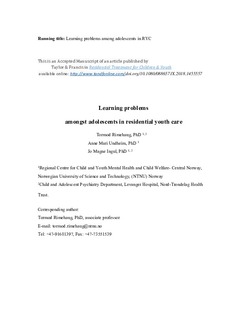| dc.contributor.author | Rimehaug, Tormod | |
| dc.contributor.author | Undheim, Anne Mari | |
| dc.contributor.author | Ingul, Jo Magne | |
| dc.date.accessioned | 2018-04-23T07:18:43Z | |
| dc.date.available | 2018-04-23T07:18:43Z | |
| dc.date.created | 2018-04-19T20:10:58Z | |
| dc.date.issued | 2018 | |
| dc.identifier.issn | 0886-571X | |
| dc.identifier.uri | http://hdl.handle.net/11250/2495391 | |
| dc.description.abstract | Limited education and educational achievement are among the many negative outcomes for adolescents in residential youth care (RYC). Because of former abuse and neglect this high-risk group is expected to have many educational problems, including learning disorders (LDs) and psychiatric disorders (PDs), which may go unrecognized, resulting in insufficient educational adaptations and increased strain for the adolescents. This study was conceived to investigate unrecognized LDs and their associations with an expected excess of PDs, social problems and weak academic performance using LD indicators based on DSM-IV criteria for LDs. The initial results led us to question the validity of these indicators blocking the possibility to detect unrecognized LDs and to reinterpret the indicators of unrecognized LDs as indicators of ‘specific underachievement not related to LD’.
The second analytic stage showed an excess of PDs, social problems and weak academic performance, but no excess of LDs except for dyscalculia. The prevalence of underachievement unrelated to LDs was 14.0% across four subtypes. This specific underachievement was associated with social problems, ADHD and substance disorders. Weak academic achievement was predicted by low IQ, specific underachievement (not related to LDs), known LDs, social problems and substance disorders among adolescents in RYC must be evaluated from a wider perspective than LDs, by including their social problems, psychiatric problems and other developmental consequences of their history of abuse and neglect. | nb_NO |
| dc.language.iso | eng | nb_NO |
| dc.publisher | Taylor & Francis | nb_NO |
| dc.title | Learning Problems among Adolescents in Residential Youth Care | nb_NO |
| dc.type | Journal article | nb_NO |
| dc.description.version | submittedVersion | nb_NO |
| dc.source.pagenumber | 24-46 | nb_NO |
| dc.source.volume | 35 | nb_NO |
| dc.source.journal | Residential Treatment for Children & Youth | nb_NO |
| dc.source.issue | 1 | nb_NO |
| dc.identifier.doi | https://doi.org/10.1080/0886571X.2018.1455557 | |
| dc.identifier.cristin | 1580468 | |
| dc.description.localcode | Locked until 19.4.2019 due to copyright restrictions. This is an [Original Manuscript] of an article published by Taylor & Francis in [Residential Treatment for Children & Youth] on [ 19 Apr 2018], available at https://www.tandfonline.com/doi/full/10.1080/0886571X.2018.1455557 | nb_NO |
| cristin.unitcode | 194,65,35,5 | |
| cristin.unitname | RKBU Midt-Norge - Regionalt kunnskapssenter for barn og unge - psykisk helse og barnevern | |
| cristin.ispublished | true | |
| cristin.fulltext | preprint | |
| cristin.qualitycode | 1 | |
